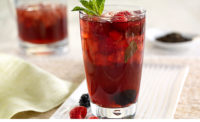Considering Clean Label
Prepared Foods’ R&D Seminars speakers discussed the many challenges and benefits when formulating with clean labels

SOURCE: @iStockphoto/djedzura





Formulating for Natural & Clean Labels with Chocolate & Confectionery Coatings
To consumers, clean labels mean “healthy.” Health and wellness has moved from being nutrition-driven (fat and sugar) to ingredient-driven and nothing artificial. To consumers, partially hydrogenated oils, artificial flavors, colors or preservatives can mean “artificial.” As explained by Russell Tietz, director of technical sales for Clasen Quality Chocolate, “Formulating clean labels is not just an ingredient swap of natural versions for an artificial synthetic version. Processing, ingredient costs, shelf life, storage, and packaging can all be affected.” He emphasized these points in his Prepared Foods’ R&D Seminar presentation titled “Formulating for Natural & Clean Labels with Chocolate & Confectionery Coatings.”
Since PHOs are essentially banned, and fully hydrogenated fats are not considered naturally processed, fractionated or interesterified palm kernel oils can provide a solution. Fractionation is a physical process to tailor the fat for specific physical properties and fractionated palm kernel oils can be labeled as “palm kernel oil.”
Tietz continued, “Processing requirements change when moving from hydrogenated to non-hydrogenated oils. Hydrogenated oils crystallize and set up at room temperature with a nice gloss and are flexible to cooling tunnel settings. Non-hydrogenated oils require attention to processing, application and cooling temperatures. Cooling temperatures of 40-45F are recommended, and cooling needs to be done immediately to avoid bloom formation, dull and wrinkled ‘skin’ surface.”
In confectionery compounds, naturally derived colors available include spirulina, carotene, turmeric, paprika, beet juice, carrot juice, red cabbage and fruit powders.
These ingredients also come with technical challenges, including higher costs, higher usage rates and shelflife stability. For best performance in coatings, naturally derived colors need to be oil-dispersed. In order to deliver the same impact in a coating as in a clear beverage, significantly higher usage rates are required.
Switching from artificial to natural flavors can impose challenges in flavor profile, intensity, and solubility. Costs and use levels are often higher, and issues with stability, intensity and shelflife can occur.
Tietz summarized by stressing the positive impact of a clean label by changing the oils, colors, emulsifiers and flavors. He cautioned that these changes are not a simple swap and to do your research in testing. Be sure to consider shelflife, costs, supply chain, processing, storage conditions and formula trade-offs in color and flavor.
“Formulating for Natural & Clean Labels with Chocolate & Confectionery Coatings,” Russell Tietz, director of technical sales, Clasen Quality Chocolate, tietzr@clasen.us
—Summary by Elizabeth Pelofske, Contributing Editor
Non GMO: Consumer Preferences, Market Trends and the Question of Supply
The Natural Marketing Institute reported that “perceived knowledge” of GMOs among consumers has doubled since 2012, reaching 22%. However, a consumer focus group confirmed that GMO knowledge is low and confusion is high. A lack of basic knowledge persists, even among consumers claiming to be experts or aware of GMOs. Of the “expert” group, 25% answered GMO questions correctly, and 75% answered incorrectly. Of those considering themselves “aware,” 10% answered correctly and 90% incorrectly.
“A clear need for more consumer education exists regarding genetically modified organisms; how they are produced; and what an official non-GMO label would present,” explained Afrouz Naeini, senior marketing manager-Sweetness & Beverage, at Ingredion, in a recent R&D Seminar presentation titled “Non GMO: Consumer Preferences, Market Trends and the Question of Supply.”
Naeini said that demand for non-GMO foods is rising, with a total of 9,000 new food and beverage launches with non-GMO claims in the US since 2012—a growth of 400% between 2012-2015. Snacks lead, with almost 2,000 new products with non-GMO claims. Naeini advised that, as awareness and concern are increasing and product launches are up, there is a need to increase the availability of non-GMO ingredients.
Take corn for example; in 2000, the US averaged 25% of total corn acres planted to genetically modified varieties. In 2007, that amount increased to 73%, and in 2015 the average was 92%. Corn is an open pollinator, meaning it will accept pollen from itself or from other corn plants. However, 97% of corn is pollinated by another plant. Any ovules pollinated by a GMO corn plant express the GM proteins in the new kernel.
“Identity preservation of non-GMO corn means keeping it separate from GM corn, and while it is a simple concept, it is complex,” elucidated Naeini. A robust traceability system is crucial to the success of non-GM procurement. Identity preservation requires a process to maintain the segregation of a distinct product and documentation of the identity of the product, making sure that what the customer orders is what is in the final product.
Naeini described a program in place today which provides non-GM corn identity preservation and traceability that meets or exceeds the regulations in major markets worldwide. Components of the program include growers using only tested and certified non-GMO seeds. Growers must provide detailed information about seed varieties, lot numbers, quantity used, and fields and dates planted. Growers are bound by contracts to follow the rigorous requirements of the program and submit to audits. When looking for non-GMO suppliers, Naeini advised to ask for documentation tracing grain back to seeds and fields; third party audits documenting each step of raw material across supply chain and through the process; and about testing and clean-out procedures.
“Non GMO: Consumer Preferences, Market Trends and the Question of Supply,” Afrouz Naeini, senior marketing manager-Sweetness & Beverage, Ingredion, afrouz.naeini@ingredion.com
—Summary by Elizabeth Pelofske, Contributing Editor
The Difference is Clean: California Fig Ingredients
California produces approximately 22 million pounds of figs annually, which are used commercially for producing dried figs. California dried figs are available year-round, while fresh figs are available from May to December. Nearly 7,000 fig-producing acres in California exist now—with an additional 1,000 acres planted for future production.
“California figs offer quality and safety assurance, with use of state-of-the-art equipment. California figs are inspected and certified for grade and quality standards; they can be traced from orchard to production facility,” offered Karla Stockli, chief executive officer, at the California Fig Advisory Board.
“Figs are nutrient-dense, offering an excellent source of fiber; with just three to five dried or fresh figs providing 5g of dietary fiber per serving. Figs also are rich in antioxidants and a good source of magnesium, calcium and potassium, while being fat- and sodium-free,” Stockli added.
Fig ingredients are available in many forms, including whole, diced, paste, pieces, juice concentrate, and fig fiber or powder. Whole dried figs fully ripen and dry naturally on the tree for maximum sweetness. Once dried, the fruit is harvested, sized and sorted. Quality fruit is then washed, inspected and packaged at state-of-the-art processing facilities. Diced figs are produced from whole dried California figs, diced to customer specifications, allowing precision integration into food products.
Fig paste comes in different consistencies: soft and conventional; with seeds and without; or with added flavors. Also produced from whole dried figs, fig pieces or nuggets are processed into fig paste, then extruded into pieces to be used in baked goods, confectionery and snacks. As a sucrose, corn syrup or molasses replacement, fig juice concentrate at 70 brix adds natural flavoring, coloring, humectant and anti-staling benefits in bread and baked goods. Fig powder is light-to-medium brown in color; free-flowing; available in different granulations; and full of fiber.
“Some applications for fig ingredients include bars, sauces, cookies, bread and gluten-free products,” advised Stockli. Nutritional bars can incorporate fig fiber, powder, pieces or paste. Fig fiber is used as a binder and moisture retainer. Fig pieces and paste add texture and flavor, and are nutrient-dense without refined sugars. In barbecue sauce, fig ingredients blend with savory ingredients to produce meaty flavors with a rich, smoky aroma and taste—also with no added refined sugars.
Fig fiber or powder also has been used as a replacement for cocoa in healthy dessert alternatives. In cookies, fig ingredients mimic molasses with rich, indulgent flavors. In bread, fig fiber is used as a starter for the dough, allowing for a moister finished product. Meatballs incorporate fig ingredients for a hint of sweet flavor and great moisture. And, in gluten-free products, fig fiber or concentrate helps mimic the browning that is found in products containing gluten. Fig fiber retains more moisture during cooking, providing better texture and flavor.
“The Difference is Clean: California Fig Ingredients,” Karla Stockli, chief executive officer, California Fig Advisory Board, 559- 243-8600, KStockli@californiafigs.com
—Summary by Elizabeth Pelofske, Contributing Editor
Apples: Cleaner Labels with Natural Sugars
Dried fruits vary in their nutrient content but, as sugar is added to fruits (such as in dried cranberries), a reduction in nutrients is seen. However, added sugar can be looked at as a friend is some situations, such as when added to a salad dressing, encouraging vegetable consumption.
“The definition of “added sugar” is not simple,” discussed Jim Painter, PhD, adjunct professor-University of Texas-Houston, School of Public Health, speaking for Tree Top. “USDA allows dried cranberries as a fruit in school lunch; however, they are not recommended by Produce for Better Health nor the US Dietary Guidelines for Americans. NuVal, an independent nutritional scoring system, subtracts points for added sugar.”
The World Health Organization (WHO) advises adults and children to reduce intake of free sugars throughout life to less than 10% of total energy intake and further states that consumption below 5% of total energy intake is beneficial. The WHO recommendations do not apply to intrinsic sugars, such as naturally found in fruits. Free sugars are mono- and disaccharides added to foods and beverages by manufacturers, cooks or consumers. Sugars naturally present in honey, syrups, fruit juices and fruit juice concentrates can be considered added sugar. Intrinsic sugars are those incorporated within the structure of intact fruit and vegetables, and sugars from milk, such as lactose and galactose.
In May 2016, FDA issued the final rule requiring declaration of added sugars and percent daily value on the Nutrition Facts panel of foods and beverages.
FDA stated that fruit purées with only intrinsic sugar are not considered added sugar for labeling purposes. “The final ruling of the FDA’s ‘Added Sugar Nutrition Facts Labeling’ states that it excludes ‘whole fruits, fruit pieces, pulps, purées and certain concentrated fruit juices that are reconstituted to full strength’ from its definition of added sugar.” added Painter.
Why sugar intrinsic in fruit is different than added sugar, is because it has a lower glycemic index and contains fiber. Sugar that is intrinsic in fruit is different than added sugar, because it has a lower glycemic index and contains fiber. Studies have shown that foods rich in polyphenols, like fruits and vegetables, may influence carbohydrate metabolism at many levels—from the muscles to the liver, pancreas, intestine and adipose tissue. Possible mechanisms include inhibition of carbohydrate digestion and glucose absorption; stimulation of insulin secretion; modulation of glucose release from the liver; and activation of insulin receptors and glucose uptake.
Apples have a high ORAC ranking and have shown many health benefits. Studies have suggested that consumption of apples, among certain other fruits, decrease risk of type two diabetes.
Americans increasingly are trying to limit or avoid gluten, lactose, sucrose and acesulfame potassium. Apple peels have been used as a flour substitute for a lower glycemic index and higher fiber cake. Apple purée can be used to replace added sugar; almonds can be used to replace wheat flour in pecan pie, newton bars and many baked goods. Fructose, approximately 20% sweeter than sucrose, is abundant in fruits, along with other sugars.
In summary, apples and other fruits have a bright future propelled by the on-going wellness trend. Fruits’ sweetness, taste and texture make them more appealing to consumers than almost any other food as a natural way to “eat healthy.”
“Apples: Formulating Cleaner Labels with Natural Sugars,” Jim Painter, adjunct professor-University of Texas-Houston, School of Public Health, 217-549-3275, jimpainterphd@gmail.com
—Summary by Elizabeth Pelofske, Contributing Editor
Originally appeared in the April, 2017 issue of Prepared Foods as Considering Clean Label.
Looking for a reprint of this article?
From high-res PDFs to custom plaques, order your copy today!








